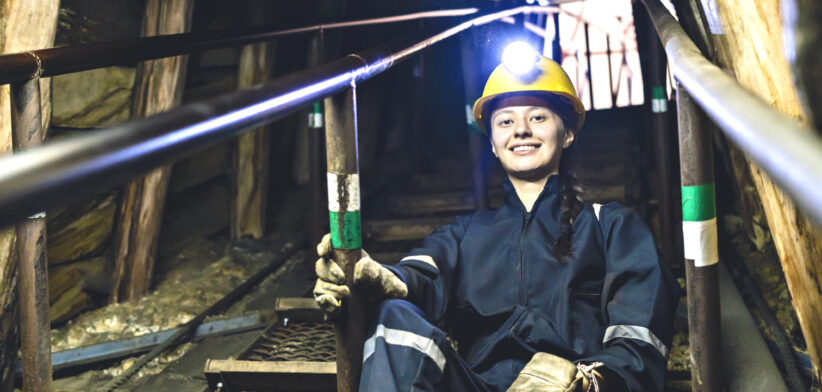Vertical Axis Wind Turbines Redefined by Machine Learning
- Brian Westenhaus - May 17, 2024
- EPFL researchers developed optimal pitch profiles for vertical-axis wind turbines using a genetic learning algorithm.
- The new pitch profiles resulted in a 200% increase in turbine efficiency and a 77% reduction in structure-threatening vibrations.
- VAWTs have advantages over traditional horizontal-axis wind turbines, including reduced noise and wildlife-friendliness.
EPFL (École Polytechnique Fédérale de Lausanne) researchers have used a genetic learning algorithm to identify optimal pitch profiles for the blades of vertical-axis wind turbines. Vertical-axis wind turbines with their high energy potential, have until now been vulnerable to strong gusts of wind.
The explanatory open access paper has been published Nature Communications.
When you consider today’s industrial wind turbine, you likely picture the windmill design, technically known as a horizontal-axis wind turbine (HAWT). But the very first wind turbines, which were developed in the Middle East around the 8th century for grinding grain, were vertical-axis wind turbines (VAWT), meaning they spun perpendicular to the wind, rather than parallel.
Due to their slower rotation speed, VAWTs are less noisy than HAWTs and achieve greater wind energy density, meaning they need less space for the same output both on- and off-shore. The blades are also more wildlife-friendly: because they rotate laterally, rather than slicing down from above, they are easier for birds to avoid.
With these advantages, why are VAWTs largely absent from today’s wind energy market? As Sébastien Le Fouest, a researcher in the School of Engineering Unsteady Flow Diagnostics Lab (UNFOLD) explains, it comes down to an engineering problem – air flow control – that he believes can be solved with a combination of sensor technology and machine learning. In the paper recently published in Nature Communications, Le Fouest and UNFOLD head Karen Mulleners describe two optimal pitch profiles for VAWT blades, which achieve a 200% increase in turbine efficiency and a 77% reduction in structure-threatening vibrations.
EPFL’s experimental VAWT blade Image Credit: © UNFOLD EPFL CC BY SA. Click the press release link for more and larger images.
Le Fouest noted, “Our study represents, to the best of our knowledge, the first experimental application of a genetic learning algorithm to determine the best pitch for a VAWT blade.”
Turning an Achilles’ heel into an advantage
Le Fouest explained that while Europe’s installed wind energy capacity is growing by 19 gigawatts per year, this figure needs to be closer to 30 GW to meet the UN’s 2050 objectives for carbon emissions.
“The barriers to achieving this are not financial, but social and legislative – there is very low public acceptance of wind turbines because of their size and noisiness,” he said.
Despite their advantages in this regard, VAWTs suffer from a serious drawback: they only function well with moderate, continuous air flow. The vertical axis of rotation means that the blades are constantly changing orientation with respect to the wind. A strong gust increases the angle between air flow and blade, forming a vortex in a phenomenon called dynamic stall. These vortices create transient structural loads that the blades cannot withstand.
To tackle this lack of resistance to gusts, the researchers mounted sensors onto an actuating blade shaft to measure the air forces acting on it. By pitching the blade back and forth at different angles, speeds, and amplitudes, they generated series of ‘pitch profiles’. Then, they used a computer to run a genetic algorithm, which performed over 3500 experimental iterations. Like an evolutionary process, the algorithm selected for the most efficient and robust pitch profiles, and recombined their traits to generate new and improved ‘offspring’.
This approach allowed the researchers not only to identify two pitch profile series that contribute to significantly enhanced turbine efficiency and robustness, but also to turn the biggest weakness of VAWTs into a strength.
“Dynamic stall – the same phenomenon that destroys wind turbines – at a smaller scale can actually propel the blade forward. Here, we really use dynamic stall to our advantage by redirecting the blade pitch forward to produce power,” Le Fouest explained. “Most wind turbines angle the force generated by the blades upwards, which does not help the rotation. Changing that angle not only forms a smaller vortex – it simultaneously pushes it away at precisely the right time, which results in a second region of power production downwind.”
The Nature Communications paper represents Le Fouest’s PhD work in the UNFOLD lab. Now, he has received a BRIDGE grant from the Swiss National Science Foundation (SNSF) and Innosuisse to build a proof-of-concept VAWT. The goal is to install it outdoors, so that it can be tested as it responds in real time to real-world conditions.
“We hope this air flow control method can bring efficient and reliable VAWT technology to maturity so that it can finally be made commercially available,” Le Fouest said.
**
One does certainly hope this development has the wherewithal to replace a lot of those dangerous ugly and noisy HAWTs. While wind is a notorious intermittent power source the industry has a lot of momentum that sucks up immense amounts of ratepayer and taxpayer money. Stamping out rent seeking plans like wind turbines could serve as an example of how terribly an economy and its citizens are damaged by political enforced rent making schemes.
It would be great of the developers could say the technology can stand economically on its own. But the press release makes no such comments. The reality is these can only supplement a bit when the winds blows.
By Brian Westenhaus via New Energy and Fuel
New York Grants Final Approvals for Empire Wind to Start Construction
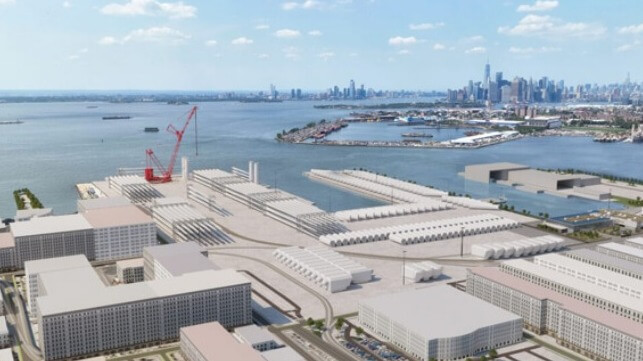
The New York State Public Service Commission granted Empire Offshore Wind its final approval, authorizing the project to begin construction on the 810MW offshore wind farm. This comes after the federal Bureau of Ocean Energy Management (BOEM) gave its final approvals for the wind farm in February and is the latest demonstration of the efforts to build momentum in the U.S. offshore energy sector.
“Offshore wind is a critically important part of our fight against climate change, and today’s decision will help move forward a zero-emissions electric grid that will provide long-term benefits to all New Yorkers,” said New York Governor Kathy Hochul.
The Certificate of Public Convenience and Necessity (CPCN) issued today authorized the construction and operation of transmission facilities for the delivery of electricity into New York from the 810 MW first section of the offshore wind farm. Equinor holds the lease won in December 2016 and signed in March 2017 for 80,000 acres south of Long Island. The anticipated commercial operation date is 2027, with first power in 2026.
BOEM issued its Record of Decision in November 2023 and its final approval of the Construction and Operations Plan for both Empire Wind 1 and 2 in February. The total project to be developed in two phases has the potential for a capacity of nearly 2.1 GW. However, Equinor only plans to move forward immediately on Phase 1 holding the second section for later solicitation.
Today’s approval includes the transmission facilities with two lines from the offshore site to Brooklyn. An onshore substation will be located at the South Brooklyn Marine Terminal and further lines will bring the power to Consolidated Edison Company of New York, Inc.’s existing Gowanus 345 kV substation in Brooklyn.
“The approval by the New York State Public Service Commission (PSC) of the Certificate of Public Convenience and Necessity is another important step for the development of the Empire Wind 1 project,” said Molly Morris, President of Equinor Renewables Americas. “With this authorization in place, combined with other federal, state, and local authorizations, critical construction can begin in Brooklyn that will help connect the 810 MW of renewable energy produced by Empire Wind 1 to the New York City grid.”
Equinor received a conditional award in February after rebidding for the power purchase agreement and was working to complete an agreement on final terms with the New York State Energy Research and Development Authority (NYSERDA). At the time, the company said it expected to complete the NYSERDA agreement in the second quarter and that a final investment decision was expected in mid-2024. Equinor said it plans to use project financing, with the financial close anticipated by the end of 2024.
“Steel in the Water” for Next Two Large U.S. Offshore Wind Farms
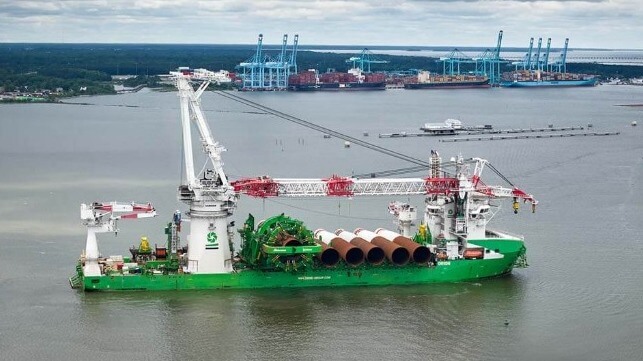
Two of the larger offshore wind farms planned for the U.S. East Coast have each gotten underway with their offshore installation. Coming just months after the commissioning of the first commercial-scale U.S. offshore wind farm it is the latest demonstration of the building momentum in the sector after the challenges in 2023.
Located roughly 15 miles south of the Rhode Island coast and 32 miles southeast of the Connecticut coast, the Revolution Wind project is adjacent to Ørsted and Eversource’s South Fork Wind, America’s first utility-scale offshore wind farm. The project also highlights that it will be the first multi-state offshore wind farm in the United States supplying power to both states.
First steel was achieved for Revolution Wind pounding in the first of the 65 turbine foundations that will hold the turbines. The project is expected to be in operation in 2025. Once in operation, it will generate 400 megawatts of offshore wind power for Rhode Island and 304 megawatts for Connecticut, enough clean energy to power more than 350,000 homes across both states.
“America’s offshore wind industry is scaling up, and the first steel in the water at Revolution Wind is a tremendous milestone for Rhode Island and Connecticut’s clean energy journey,” said David Hardy, Group EVP and CEO Americas at Ørsted. “We’re building on our successful track record with the Block Island Wind Farm and South Fork Wind, and Revolution Wind can generate more than four times as much power as those two projects put together, demonstrating the enormous economic opportunity of offshore wind.”
Three New England ports are supporting the effort to build Revolution Wind. In New London, Connecticut, the first of Revolution Wind’s turbine components have started arriving at State Pier, the staging and marshaling port for the project, where they will be assembled before transfer to the site. In Providence, Rhode Island, crews are also readying for loadout of foundation components, which were built at Ørsted and Eversource’s construction hub at ProvPort. The crew helicopters and crew transfer vessels are operating from the state’s Quonset Point facility.
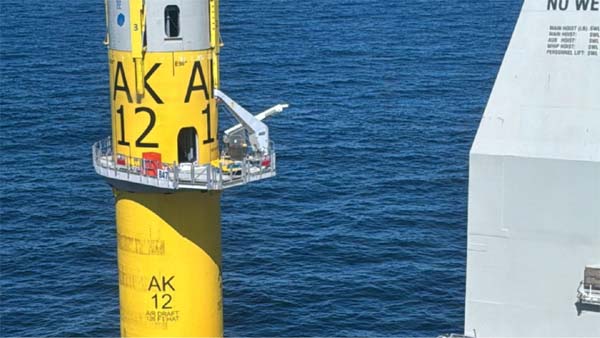
Revolution Wind installed the first of 65 foundations for the 704 MW wind farm (Orsted)
To the south, off the coast of Virginia, the first six foundations headed out last weekend for Dominion Energy’s Coastal Virginia Wind Farm. It will be the largest offshore farm so far in the United States slated to provide 2.6 GW once fully constructed in late 2026. CVOW will consist of 176 turbines and three offshore substations in a nearly 113,000-acre lease area off the coast of Virginia Beach.
The monopole foundations were being moved to the site which is 30 miles off Virginia Beach. DEME’s vessel Orion has already arrived and it will be conducting the installations. Because the project is sited in an area for seasonal North Atlantic right whale migration, the installation will be conducted this October 31 this year.
As both projects move forward, the Bureau of Ocean Energy Management is also continuing to push forward on the review of additional projects. It also mapped out its mid-term plan for site development and moved toward the next auctions in the Gulf of Mexico and the first in the Gulf of Maine.
Assembly Starts for First U.S. Rock Installation Vessel for Offshore Wind
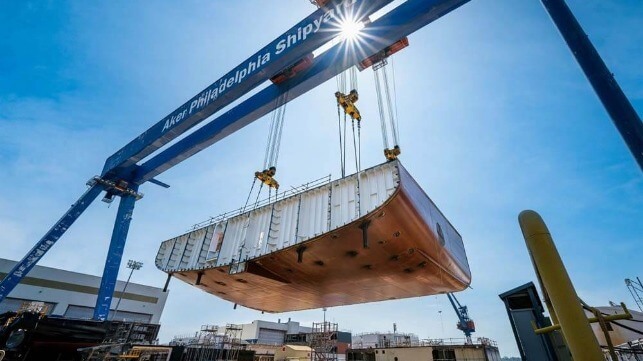
Great Lakes Dredge & Dock Corporation reports that construction has begun on its subsea rock installation vessel, the first of its kind planned for the U.S. and the first to be Joens Act complaint. The vessel is part of the company’s long-term growth strategy to enter the U.S., and possibly internationally, offshore wind market. The vessel is designed to put the company in a unique business position in the U.S. market while it also continues to pursue and tender bids both domestically and internationally.
The first section, known as the grand block, was placed into the assembly dry dock at the Philly Shipyard on May 2. The company first announced its intentions for the vessel in December 2020 and confirmed the order with Philly Shipyard in November 2021. Work on the vessel began in the summer of 2023 with a ceremonial first steel cut attended by President Joe Biden.
The yard reported the contract was for $197 million for the first vessel, originally scheduled for delivery in the fourth quarter of 2024, and with Great Lakes retaining a right of first refusal on a second ship possibly for the fourth quarter of 2025. The total value of the order if both vessels are built would be $382 million.
The basic design was developed by Ulstein and it will be unique in the U.S. market as the only purpose-built vessel to lay rocks and material used to protect and stabilize foundations and cables for offshore wind farms. The vessel will be 461 feet (140.5 meters) with crew accommodations for 45 people and a capacity to carry up to 20,000 MT of rock.
“Keel laying, commonly referred to as the birthday of a ship, is a big milestone in the ship construction process, said Lasse Petterson, CEO of Great Lakes. “We are so pleased to be at this stage with our new vessel, as we can see the results of years of planning and engineering coming together with Philly Shipyard.”
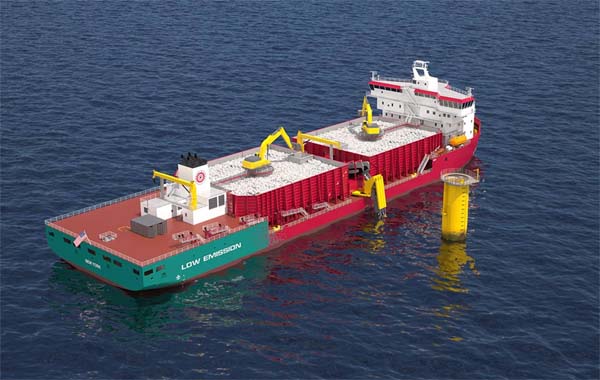
Rendering of the rock installation vessel (Great Lakes Dredge & Dock)
The new vessel, the Acadia, already has contracts to provide critical services to Equinor’s Empire Wind 1 wind farm in New York in 2025 and Ørsted’s Sunrise Wind project. Today, New York State granted final approval for the Empire Wind 1 project moving it a step closer to construction. Equinor has said work would begin at the onshore site in Brooklyn with a final investment decision expected before the end of this year.
Great Lakes, however, was also notified by Equinor that it was canceling a second contract that had been awarded in consortium with Van Ord. That cancellation was announced in January for the work planned in 2026 on Empire Wind II. Equinor has said it was holding the second phase of the wind farm after canceling its power purchase agreement with New York State. The company received approvals from the federal government but would need to submit the project in a future New York solicitation.
The company recently told investors during its first quarter financial report that it expects to take delivery of the Arcadia in 2025. They said they were pursuing and bidding on projects both in the U.S. and internationally for 2026 and beyond.
At the first steel cut in July 2023, President Biden highlighted that the vessel is one of 18 offshore wind shipbuilding projects as well as investments of nearly $3.5 billion across 12 manufacturing facilities and 13 ports to develop the U.S. offshore wind supply chain. The vessels are being built at shipyards ranging from Florida to Louisiana, New York, Massachusetts, Michigan, Rhode Island, Wisconsin, and Pennsylvania. A month ago, Dominion Energy announced that its wind turbine installation vessel, also the first being built in the United States, had been launched at a shipyard in Texas.



